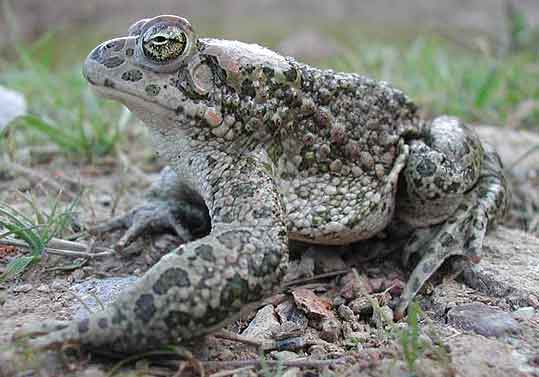Bufo viridis (*) Cladus: Eukaryota Name Bufo viridis Laurenti, 1768 Type locality: "inter fissuras, seu cavernas murorum obscuras Viennae", Austria. Holotype: Including frog figured on pl. 1, fig. 1 of original publication. Synonyms * Bufo viridis Laurenti, 1768 * Pseudepidalea viridis if one recognizes the opinionated splitting of the genus Bufo by Frost et al. (2006) References * Laurenti, 1768, Spec. Med. Exhib. Synops. Rept.: 27. Vernacular names ------------- The European green toad (Bufo viridis or Pseudepidalea virdis) is a toad found in mainland Europe, Asia, and Northern Africa. They live in many areas, including steppes, mountainous areas, semi-deserts, and urban areas. There are variations in the colors and patterns of these toads across their range. The spots on their backs are usually anything from green to dark brown and sometimes red spots appear, too. Most toads have white or very lightly colored stomachs. The toads eat a variety of insects and invertebrates, mainly crickets, meal worms, small butterflies, earthworms, moths, beetles and caterpillars. These toads will change their color in response to heat and light changes, but to a greater degree than others. Also similar to other toads, the European Green Toad has glands behind its neck that secrete a toxin when the toad is threatened. Female toads are larger than males and can lay 9,000 to 15,000 eggs at a time. They can reach a maximum size of 6 inches, but growth to this size is rare.
* Stöck, Matthias; Craig Moritz, Michael Hickerson, Daniel Frynta, Tatjana Dujsebayeva, Valery Eremchenko, J. Robert Macey, Theodore J. Papenfuss and David B. Wake (02-06-06). "Evolution of mitochondrial relationships and biogeography of Palearctic green toads (Bufo viridis subgroup) with insights in their genomic plasticity". Molecular Phylogenetics and Evolution 41 (3): 663–689. Source: Wikispecies, Wikipedia: All text is available under the terms of the GNU Free Documentation License |
|

